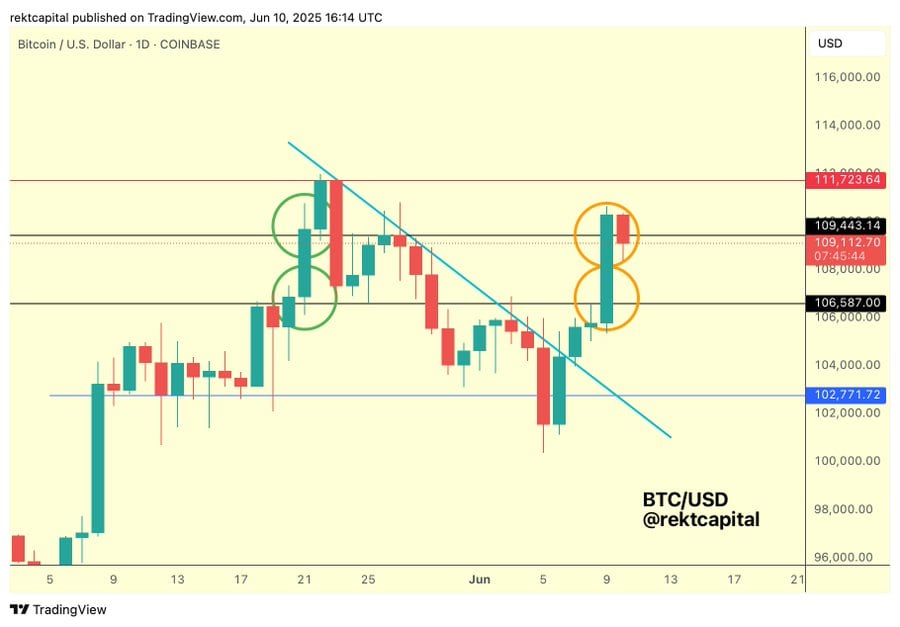
The key catalyst? America’s balance sheet is on fire, and Trump wants to throw more gasoline on it.
In Bitwise’s latest weekly crypto outlook, the analysts make the case that fiscal instability in the U.S. — driven by ballooning federal debt and the latest iteration of Trump’s tax-slashing fantasy, the so-called “One Big Beautiful Bill Act” — is laying the groundwork for a Bitcoin bull run that could melt faces.

Bitcoin is back to $109,000 and looking strong, Source: BNC Bitcoin Liquid Index
Bitcoin as the Anti-Dollar
If Trump’s tax proposals pass (and yes, there’s a non-zero chance he’s back in the Oval Office in 2025), mandatory federal spending will continue to outpace revenues by a disturbing margin. The Congressional Budget Office projects that net interest payments on U.S. debt will triple to $3 trillion by 2030, turning America’s debt spiral into a whirlpool.
That’s precisely the kind of chaos that Bitcoin was built for.
“Bitcoin’s scarcity and resilience position it uniquely to benefit from both fiscal instability and improving market sentiment,” Bitwise analysts wrote. Translation: Bitcoin is Plan ₿.
Musk vs Trump = BTC Dip Buying Opportunity
Recent market behavior underlines Bitcoin’s reflexivity to political drama. When Elon Musk took a public swipe at Trump’s “One Big Beautiful Bill” last week, a social media spat broke out, Bitcoin dropped 6% to around $100K, and then surged right back as shorts got liquidated.
Bitwise says this is just more evidence of Bitcoin’s new role as a macro hedge — less “risk asset,” more “digital credit default swap on the U.S. Treasury.”
Technical analyst Rekt Capital wrote that Bitcoin had a “Phenomenal Daily candle yesterday, breaking through ~$106,600 (black) resistance comfortably In fact, Bitcoin has skipped through the $106,600-$109,443 Daily Range entirely (black-black) Bitcoin is once again positioning itself like in late May for a retest (green circle) Retest is now in progress and a Daily Close above $109.443 (red) would enable a revisit of the final Daily resistance before new All Time Highs (red $111,723)

Bitcoin is positioning for new All Time Highs, Source: X
Meanwhile, Bitwise CIO Matt Hougan doubled down on this price target in a recent interview with Cointelegraph, saying the surge in institutional demand post-ETF approvals is creating a Bitcoin supply shock. “We think the market is underestimating how little BTC is actually for sale,” Hougan said.
Tether Goes Cypherpunk: Plans Open-Source Bitcoin Mining OS to Cut Out the Middlemen
Tether, the stablecoin juggernaut behind USDT, is gearing up to disrupt yet another corner of crypto — and this time, it’s aiming squarely at the hardware layer. CEO Paolo Ardoino announced that Tether is developing an open-source Bitcoin mining operating system — dubbed “Moria” (or just “MOS” for now) — which is set to launch by Q4 2025.
The move? A direct shot at the walled-garden ecosystem of overpriced, proprietary mining software. Ardoino’s message is clear: the Bitcoin mining industry is due for a decentralization makeover — and third-party vendors are no longer welcome.
“A horde of new Bitcoin mining companies will be able to enter the game and compete to keep the network safe,” Ardoino posted on X, channeling Satoshi vibes.

Tether will work towards open-sourcing its Bitcoin Mining OS, said CEO Paolo Ardoino, Source: X
Peer-to-Peer by Design
According to Ardoino, the MOS is built from the ground up to be modular, scalable, and peer-to-peer — leaning heavily into Internet of Things architecture. That means seamless integration across diverse mining infrastructure, including shipping container rigs, off-grid power systems, and other Frankenstein-like hardware setups that many independent miners use.
Tether’s vision is to democratize mining software and give small and mid-size operations the tools to go toe-to-toe with the Bitmains and MARAs of the world.
Why It Matters: The Battle for Mining Sovereignty
Today’s mining landscape is dominated by massive players with deep pockets, cheap energy contracts, and scale-driven advantages. This leaves most aspiring miners locked out or dependent on centralized vendors for software, firmware, and control.
Tether’s move to open-source MOS is a philosophical and strategic play — betting that the next wave of mining growth won’t come from megafarms, but from smaller, more nimble, sovereign miners armed with better tools.
It also continues a broader decentralization push from Tether, which partnered with the Ocean mining pool in April to decentralize block-building by committing its hashrate to the open protocol.
AI Is the New Crypto? Not So Fast
Meanwhile, mining companies are split on where their future lies. Post-halving, many have pivoted to AI infrastructure to stay profitable. Hive Digital, for example, now earns more revenue from AI compute workloads than Bitcoin mining — and they’re not alone.
“Institutions are much more interested in us with our AI than Bitcoin,” Hive chairman Frank Holmes told Cointelegraph.
And yet, some miners are doubling down on Bitcoin. Cango, for instance, ditched legacy business segments entirely and racked up $100 million in BTC in just two months, showing that hyper-focus on mining still pays — if you do it right.
Tether’s open-source MOS could be a game-changer, lowering the barrier to entry for would-be miners and rebalancing power away from the incumbents. If Bitcoin is digital gold, then mining software is the pickaxe — and Tether just handed everyone a free one.


 4 days ago
4
4 days ago
4 










 Bengali (Bangladesh) ·
Bengali (Bangladesh) ·  English (United States) ·
English (United States) ·